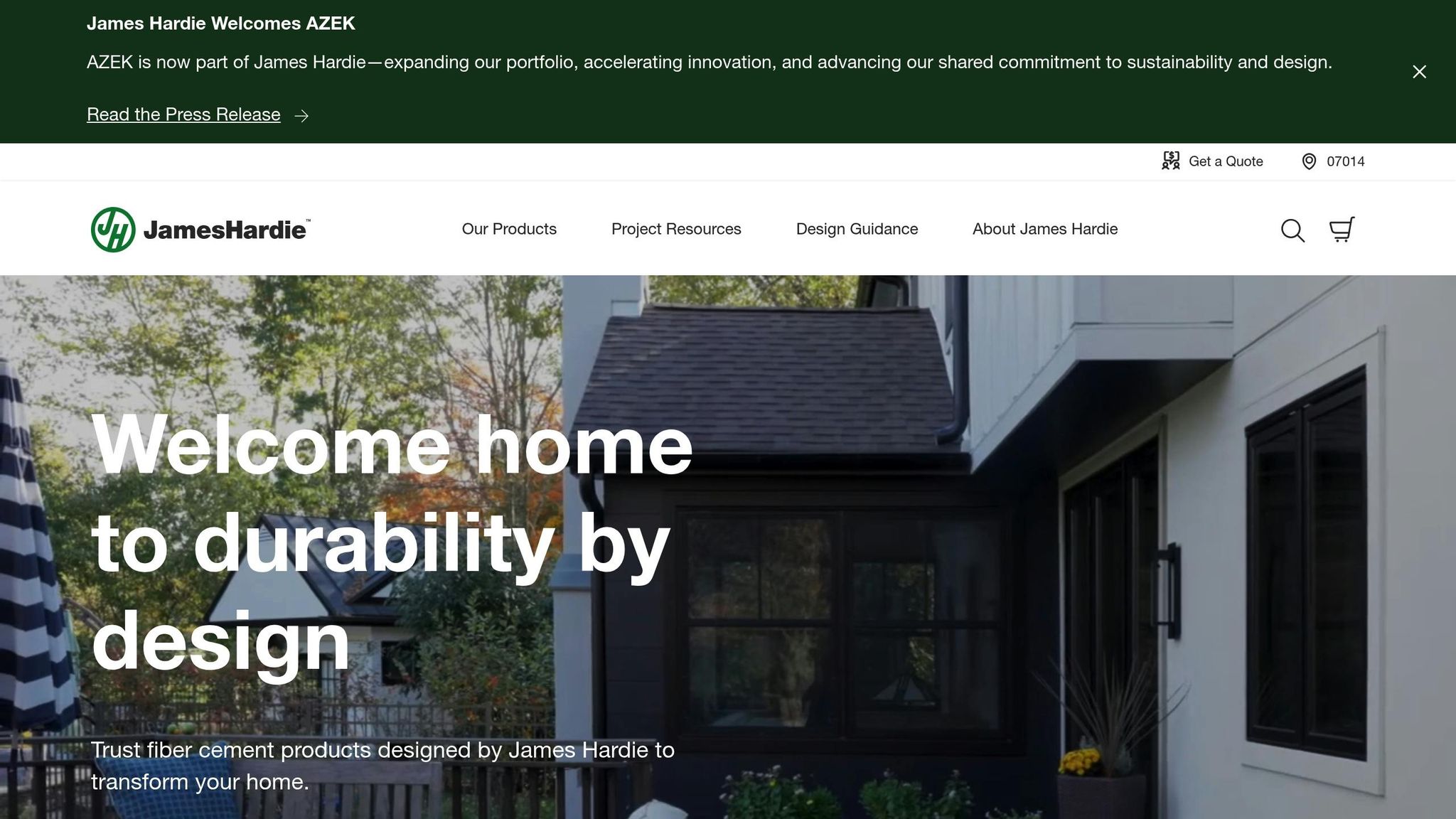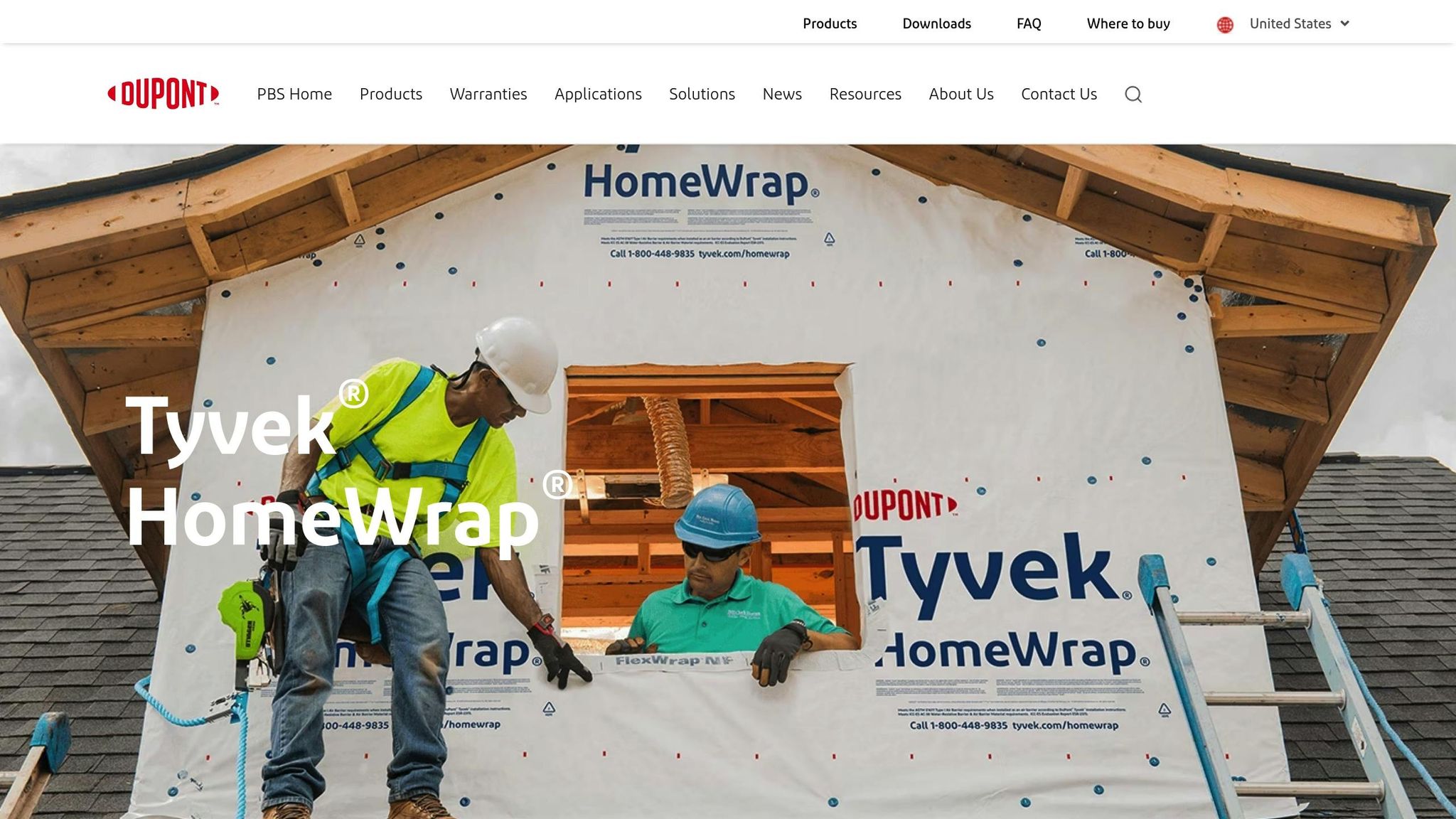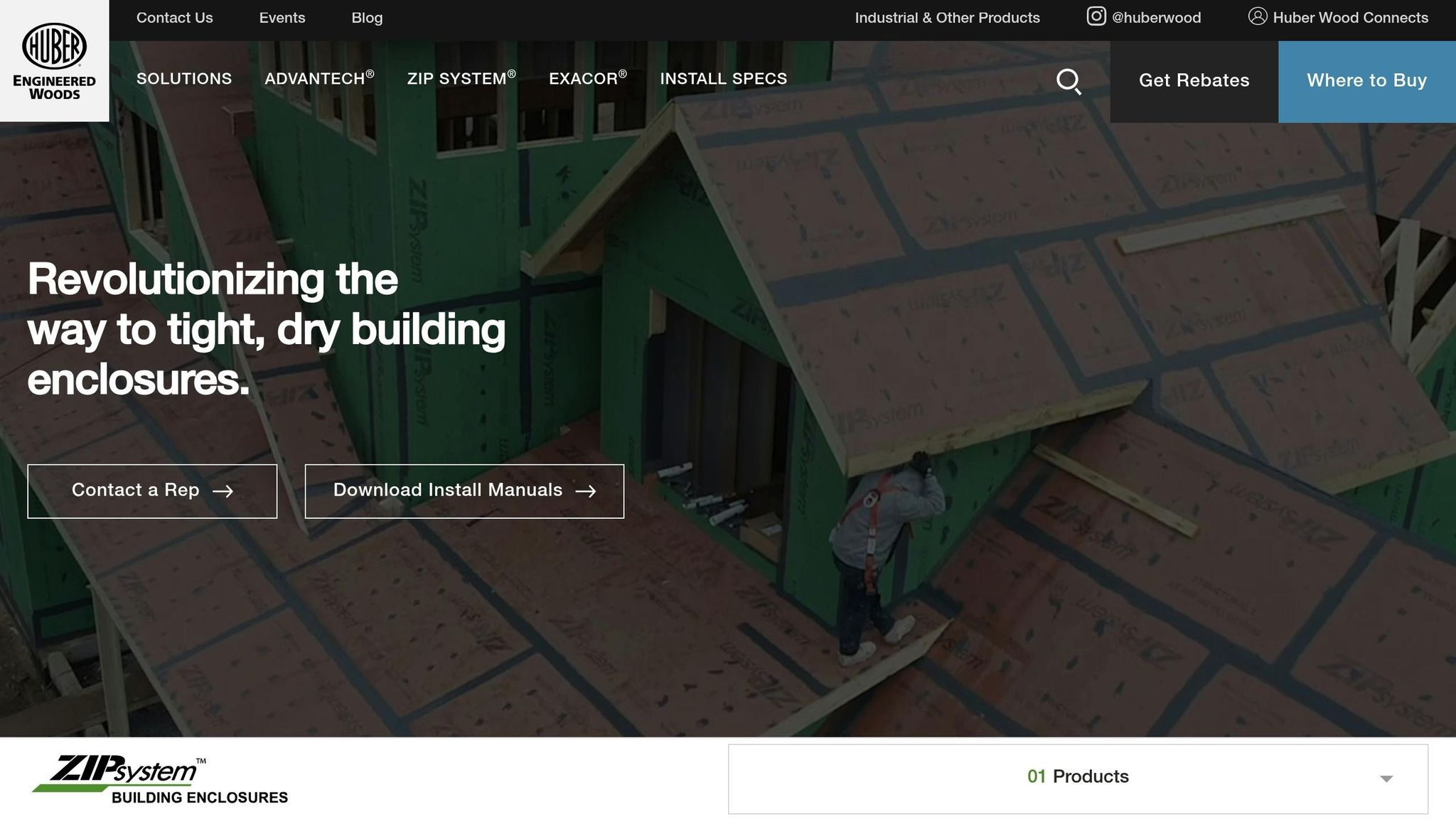


James Hardie Wrap: Moisture Control Benefits

Make an appointment
Get a Free Estimate Today
James Hardie Wrap: Moisture Control Benefits
James Hardie Wrap is a top-tier weather barrier designed to protect homes from moisture-related issues. Here's why it stands out:
- Moisture Defense: Its MicroTech coating blocks water while allowing vapor to escape, reducing mold risks.
- Climate-Specific Design: Tailored for U.S. regions - HZ5 (cold/wet climates) offers 25-perm vapor permeability, while HZ10 (hot/humid climates) has a 15-perm rating.
- Durability: At 11-mil thickness, it's 9x stronger than competitors, resists UV for 180 days, and minimizes installation tears.
- Installation: Lightweight and easy to handle, it requires proper overlapping and seam sealing for maximum effectiveness.
Quick Comparison
| Feature | James Hardie Wrap | Tyvek HomeWrap | ZIP System |
|---|---|---|---|
| Thickness | 11-mil | Standard | Integrated panel |
| UV Resistance | 180 days | 4 months | 3 months |
| Perm Rating | 15–25 | 54 | 1–3 (OSB layer) |
| Water Hold-Out | 325 mm | Standard | Built-in barrier |
| Installation | Wrap + sealing | Wrap + sealing | Panel + tape |
| Cost | Premium | Moderate | Higher |
For moisture control and durability, James Hardie Wrap leads, especially for fiber cement siding or areas with extreme weather. Proper installation ensures long-term protection.
How to Install HardieWrap Weather Barrier
1. James Hardie Wrap

James Hardie Wrap is a nonwoven synthetic weather barrier designed to address moisture issues across the U.S. Unlike traditional woven house wraps, which can allow water to seep through their fabric, Hardie Wrap uses advanced materials to provide a dependable shield against moisture.
Moisture Resistance
The key to its moisture protection lies in its MicroTech coating technology. This coating creates a strong barrier against bulk water and wind-driven rain while still allowing the material to breathe. With a water hold-out rate of 325 mm, it offers excellent moisture defense. The wrap also boasts an 11-mil thickness, which enhances its durability and reduces the likelihood of tears during installation.
Vapor Permeability
Hardie Wrap goes beyond just water resistance by offering climate-specific vapor control. Through the HardieZone® system, James Hardie has developed two formulations tailored to distinct U.S. regions:
- HZ5 (Cold/Wet Climates): Designed for northern areas, it has a 25-perm rating, ensuring higher vapor permeability where it's needed most.
- HZ10 (Hot/Humid Climates): Ideal for southern regions, it features a 15-perm rating to manage moisture effectively in warmer, more humid conditions.
This regional approach ensures that the wrap performs optimally no matter the climate. Classified as a Class 4 Vapor Permeable Membrane, it meets NCC 2022 Condensation Management standards. In March 2025, Callaway Construction, a James Hardie–approved contractor in Sioux Falls, SD, recommended Hardie Wrap for fiber cement siding installations, highlighting its climate-specific perm ratings and the advantages of the 15- and 25-perm options.
Durability
Built for longevity, James Hardie Wrap is nine times stronger than other leading house wraps. It also provides 180 days of UV protection, giving contractors plenty of time to complete installations without worrying about sun damage. In August 2018, WestPro Roofing praised Hardie Wrap as an excellent choice for Colorado homeowners, emphasizing its durability, 11-mil thickness, and MicroTech coating. These features make it a reliable option for long-term protection.
Installation Requirements
Proper installation is essential to maximize the wrap's protective capabilities. The wrap should overlap at least 1 inch on the sides and 6 inches at the ends to ensure continuous coverage. James Hardie offers a range of complementary products, including HardieWrap Flashing, Pro-Flashing, and Flex Flashing, to secure critical areas like openings and joist spaces. Sealing all seams with HardieWrap Seam Tape is also crucial for maintaining the barrier's integrity. Additionally, its lightweight design makes handling and cutting easier, helping to reduce labor time.
2. Tyvek HomeWrap

Tyvek HomeWrap is a popular choice for weather barriers in U.S. construction, offering a unique approach to managing moisture compared to James Hardie Wrap. Let’s break down its performance in key areas.
Moisture Resistance
Tyvek HomeWrap is designed to block bulk water from penetrating the building envelope while allowing moisture vapor to escape, helping to prevent condensation issues inside walls. However, it lacks surfactant resistance, which means it can be more prone to damage in extreme weather conditions, particularly during high winds or heavy moisture exposure.
Vapor Permeability
One standout feature of Tyvek HomeWrap is its high vapor permeability. It boasts a water vapor transmission rate of approximately 54 perms, as tested under ASTM E96-05 Method B. While building codes require a minimum of about 5 perms, DuPont experts suggest that moderate to high permeability levels are preferable for effective weatherization. Still, this level of permeability might not be the best fit for every climate, as a one-size-fits-all approach doesn’t always account for regional variations.
Durability
Tyvek HomeWrap offers up to 4 months of UV resistance, giving builders a decent timeframe for installation. Its polyethylene fiber construction ensures basic durability, but the thinner material makes it less robust under environmental stress compared to thicker options on the market.
Installation Requirements
Proper installation is critical to getting the most out of Tyvek HomeWrap. It should be applied over the sheathing and under the siding, with careful attention to overlapping and sealing seams to minimize exposure to wind and moisture, especially within its 4-month UV resistance period. One challenge is its opacity, which can make it harder to locate fastening points and align materials. This, combined with its susceptibility to wind and moisture damage, means extra care is needed during installation, particularly in harsh weather conditions.
sbb-itb-85e0110
3. ZIP System

The ZIP System takes moisture and vapor management to the next level by combining structural sheathing and a weather barrier into a single, easy-to-install panel. This design simplifies the construction process while maintaining high performance.
Moisture Resistance
What sets the ZIP System apart is its ability to merge structural sheathing with a built-in water-resistant barrier. This all-in-one panel eliminates the need for separate house wraps, which can tear or shift during installation. To ensure maximum protection against water intrusion, seams must be sealed with ZIP System tape or liquid flash. This approach not only stops liquid water but also controls vapor, reducing the chance of unwanted condensation within the wall structure.
Vapor Permeability
The ZIP System is designed to let moisture vapor escape while keeping liquid water out. Its OSB layer has a permeability rating of 1–3 perms, while the overlay provides 12–16 perms. This balance minimizes the risk of condensation building up inside the walls.
Durability
One of the standout features of the ZIP System is its durability. These panels can handle exposure to the elements for up to 180 days. This is especially useful for projects facing delays or in areas where weather conditions are unpredictable.
Installation Requirements
Thanks to its integrated design, the ZIP System simplifies installation. However, to maintain the barrier's effectiveness, every panel joint must be sealed with ZIP System tape or liquid flash. The product is widely accepted by building codes across North America, offering reliable air barrier performance when installed correctly.
Advantages and Disadvantages
When it comes to weather barrier systems, each option has its own set of pros and cons. Knowing these can help homeowners choose the right product for their specific climate and installation needs.
James Hardie Wrap is known for its durable construction and climate-specific design. Its 11-mil thickness and patented MicroTech coating strike a balance between water resistance and vapor permeability, making it an excellent match for fiber cement siding. However, this high performance comes with a premium price tag compared to other nonwoven synthetic barriers.
Tyvek HomeWrap is valued for its high vapor permeability rating of 56 perms, which makes it a reliable choice for open stud construction. It also supports proper weatherboard lap installation at window openings. But it has some downsides, including vulnerability to wind and moisture and limited surfactant resistance. Improper installation - like reverse laps - can trap water instead of letting it drain, leading to potential issues.
ZIP System combines structural sheathing with a factory-applied weather barrier, simplifying installation and boosting wind resistance when applied correctly. However, its tape sealing can create failure points, and its OSB substrate tends to absorb moisture. With a low perm rating of just 1, it restricts moisture vapor movement, which can lead to problems if warranty conditions aren’t carefully followed.
Here’s a quick comparison of the key features:
| Feature | James Hardie Wrap | Tyvek HomeWrap | ZIP System |
|---|---|---|---|
| Thickness | 11-mil | Standard nonwoven | Integrated panel |
| UV Resistance | 180 days | 4 months | 3 months |
| Perm Rating | 15–25 | 56 | 1 |
| Water Hold-Out | 325 mm (≈12.8 in) | Standard | Integrated barrier |
| Installation | Traditional wrap | Traditional wrap | Claims 40% faster* |
| Cost | Premium pricing | Moderate | Higher than traditional |
| Durability | Puncture-resistant | Susceptible to wind/moisture damage | Tape-dependent |
*ZIP System claims to reduce installation time by 40%, but actual time savings are often minimal.
Choosing the right weather barrier often comes down to the needs of the project. For instance, James Hardie Wrap® is highly recommended for use behind James Hardie siding due to its impressive protection and durability.
Climate also plays a big role. In regions with high UV exposure, products with extended UV resistance are ideal, while areas prone to extreme weather benefit from strong moisture management. With a perm rating between 10 and 20, James Hardie Wrap is versatile enough for a wide range of applications.
Installation complexity varies as well. While the ZIP System promises faster installation, the actual time saved may not be as significant as advertised. On the other hand, traditional wraps like James Hardie Wrap and Tyvek HomeWrap require careful attention to details like overlaps and fastenings to ensure proper performance.
Conclusion
After thoroughly analyzing weather barrier systems, it's clear that Hardie Wrap stands out as the top choice. By examining factors like moisture control, durability, and performance across different climates, Hardie Wrap proves itself with advanced features and reliable protection.
Thanks to its patented MicroTech coating, Hardie Wrap is built to be nine times stronger than other leading options, offering exceptional moisture control and long-lasting defense. Beyond protecting against moisture, it also helps improve energy efficiency by minimizing air leaks and moisture penetration. This helps maintain consistent indoor temperatures, which could lead to lower energy bills over time. With over 30 years of engineering expertise behind it, Hardie Wrap is a product designed to last.
What sets Hardie Wrap apart even further is its climate-specific engineering. The HardieZone system is tailored to handle both cold, wet climates and hot, humid conditions. For homeowners using fiber cement siding, James Hardie emphasizes Hardie Wrap as "a final defense against siding failure".
For your next exterior renovation or new construction project, Hardie Wrap is the clear choice. Its advanced moisture control, climate-specific design, and proven durability make it a smart way to protect your home and ensure its long-term value.
To safeguard your home with Hardie Wrap, contact Bayshore Exteriors for expert installation and advice on Hardie Wrap and fiber cement siding solutions.
FAQs
What makes the MicroTech coating on James Hardie Wrap better for moisture control than standard house wraps?
The MicroTech coating on James Hardie Wrap is designed to manage moisture effectively by balancing water resistance with vapor permeability. In simple terms, it keeps water out of your home while letting trapped moisture escape. This reduces the chances of mold, mildew, and even structural damage.
Thanks to this advanced moisture control and proper ventilation, James Hardie Wrap helps ensure your home stays dry, sturdy, and energy-efficient. It's a dependable option for any exterior project.
What makes James Hardie Wrap effective for moisture control in various U.S. climates?
James Hardie Wrap is tailored to meet the specific moisture control needs of various U.S. climates. In cooler, wetter regions, its perm rating of 25 allows water vapor to escape, which helps minimize the chances of mold and moisture buildup. Meanwhile, in warmer, more humid areas, the wrap's perm rating of 15 offers a balance between water resistance and breathability, preventing trapped moisture while ensuring long-lasting durability.
This thoughtful design delivers dependable protection across a range of environments, safeguarding your home from moisture problems and contributing to its long-term resilience.
How can you properly install James Hardie Wrap to maximize moisture protection and durability?
To get the best moisture protection and durability from James Hardie Wrap, follow these essential steps:
- Overlap seams by at least 6 inches to block water from seeping through.
- Tape all seams - both vertical and horizontal - to create a secure, watertight seal.
- Ensure the sill plate is covered with at least a 6-inch overlap for extra defense against moisture.
- Install the wrap before adding windows and doors to properly seal around these openings.
- Use appropriate flashing at penetrations, junctions, and wall openings to guide water away from areas prone to leaks.
Store the wrap in a sheltered location, away from chemicals and direct sunlight. To maintain its effectiveness, make sure it’s covered with siding or other materials within 180 days of installation.